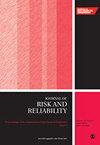用于预报和健康管理的 HSMM 多观测系统
IF 1.8
4区 工程技术
Q3 ENGINEERING, INDUSTRIAL
Proceedings of the Institution of Mechanical Engineers Part O-Journal of Risk and Reliability
Pub Date : 2024-03-25
DOI:10.1177/1748006x241238582
引用次数: 0
摘要
有效的维护策略可以确定系统的当前状态(诊断阶段)和未来状态(预后阶段)。我们在本文中指出,马尔可夫方法可以为专家提供许多有效指标。为了说明这些方法的质量和鲁棒性,我们比较了隐半马尔可夫模型(HSMM)和隐马尔可夫模型(HMM)。比赛中包括了几种学习和解码方法。一个真实案例研究被用作特别有趣的工作工具。剩余使用寿命 (RUL) 也被纳入了这项工作。本文章由计算机程序翻译,如有差异,请以英文原文为准。
HSMM multi-observations for prognostics and health management
An efficient maintenance policy allows for determining the current state of a system (diagnosis phase) and its future state (prognosis phase). We show in this paper that Markovian methods allow for obtaining many efficient indicators for the expert. To characterize the quality and robustness of these methods, we compared the Hidden Semi-Markov Model (HSMM) with the Hidden Markov Model (HMM). Several learning and decoding methods were included in the competition. A real case study was used as a particularly interesting working tool. The Remaining Useful Life (RUL) has also been included in this work.
求助全文
通过发布文献求助,成功后即可免费获取论文全文。
去求助
来源期刊

Proceedings of the Institution of Mechanical Engineers Part O-Journal of Risk and Reliability
ENGINEERING, MULTIDISCIPLINARY-ENGINEERING, INDUSTRIAL
CiteScore
4.50
自引率
19.00%
发文量
81
审稿时长
6-12 weeks
期刊介绍:
The Journal of Risk and Reliability is for researchers and practitioners who are involved in the field of risk analysis and reliability engineering. The remit of the Journal covers concepts, theories, principles, approaches, methods and models for the proper understanding, assessment, characterisation and management of the risk and reliability of engineering systems. The journal welcomes papers which are based on mathematical and probabilistic analysis, simulation and/or optimisation, as well as works highlighting conceptual and managerial issues. Papers that provide perspectives on current practices and methods, and how to improve these, are also welcome
 求助内容:
求助内容: 应助结果提醒方式:
应助结果提醒方式:


